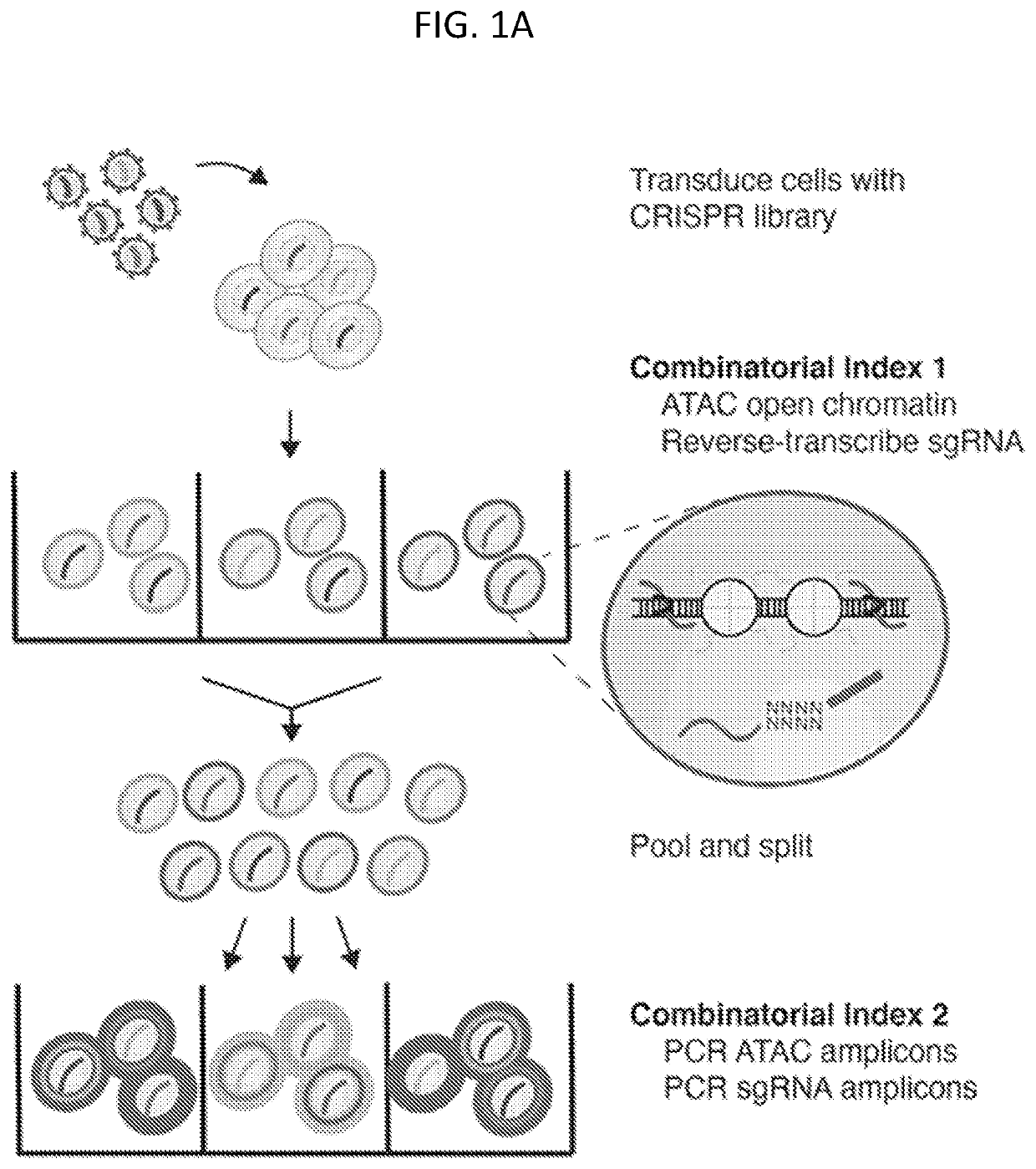Methods and compositions for scalable pooled RNA screens with single cell chromatin accessibility profiling
a single cell, chromatin accessibility technology, applied in biochemistry, instruments, enzymology, etc., can solve the problems of inability to measure consistency between perturbations, limited experiment volume, and difficult to know the degree to which off-target effects are responsible for observed phenotypes
- Summary
- Abstract
- Description
- Claims
- Application Information
AI Technical Summary
Benefits of technology
Problems solved by technology
Method used
Image
Examples
example 1
[0130]Cell Culture and Monoclonal K562-Cas9 Cell Line
[0131]NIH-3T3 and K562 cells were acquired from ATCC (CRL-1658 and CCL-243). HEK293FT cells were acquired from Thermo Fisher (R70007). NIH-3T3 (mouse) and HEK293FT (human) cells were maintained at 37° C. with 5% CO2 in D10 media: DMEM with high glucose and stabilized L-glutamine (Caisson DML23) supplemented with 10% fetal bovine serum (Thermo Fisher 16000044). K562 cells were maintained at 37° C. with 5% CO2 in R10 media: RPMI with stabilized L-glutamine (Thermo Fisher 11875119) supplemented with 10% fetal bovine serum.
[0132]To generate monoclonal K562 cells expressing Cas9, K562 cells were transduced with lentiCas9-Blast (Addgene 52962) at a multiplicity of infection (MOI) of 0.1 and selected and maintained in R10 with 5 μg / ml blasticidin. Monoclonal K562-Cas9 cells were isolated and expanded through limiting dilution. Expression of Cas9 was confirmed by Western blot using an anti-2A peptide antibody (Millipore Sigma MABS2005).
[0...
example 2
Pooled Crispr Screens with Single Cell Chromatin Accessibility Profiling
[0186]To study how genetic perturbations affect chromatin states and cellular phenotypes, a novel platform was developed for scalable pooled CRISPR screens with single-cell ATAC-seq profiles: CRISPR-sciATAC. In CRISPR-sciATAC, we simultaneously capture Cas9 single-guide RNAs (sgRNAs) and perform single-cell combinatorial indexing ATAC-seq′ (FIG. 1A and FIG. 2A). Following cell fixation and lysis, nuclei are recovered and the open chromatin regions of the genomic DNA undergo barcoded tagmentation in a 96-well plate using a unique, easy-to purify transposase purified from Vibrio parahemolyticus (FIG. 1B, FIG. 3A-FIG. 3G). Next, the sgRNA is barcoded with the same barcode as the ATAC fragments, using in situ reverse transcription. The nuclei are pooled together and split again to a new 96-well plate and both the ATAC fragments and the sgRNA are tagged again with a well-specific barcode in two consecutive PCR steps....
PUM
| Property | Measurement | Unit |
|---|---|---|
| Temperature | aaaaa | aaaaa |
| Fraction | aaaaa | aaaaa |
| Fraction | aaaaa | aaaaa |
Abstract
Description
Claims
Application Information
 Login to View More
Login to View More - R&D
- Intellectual Property
- Life Sciences
- Materials
- Tech Scout
- Unparalleled Data Quality
- Higher Quality Content
- 60% Fewer Hallucinations
Browse by: Latest US Patents, China's latest patents, Technical Efficacy Thesaurus, Application Domain, Technology Topic, Popular Technical Reports.
© 2025 PatSnap. All rights reserved.Legal|Privacy policy|Modern Slavery Act Transparency Statement|Sitemap|About US| Contact US: help@patsnap.com



